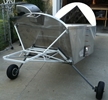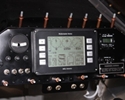


random user submitted photo
Crankshaft end float shimming
2 posts
• Page 1 of 1
Crankshaft end float shimming
Hi everyone,
Back in May I purchased Onex 0069 from her second owner and then had an agonizing wait while I completed my check-ride, tail-wheel, and transition training.
Finally in October I was ready to fly to Oshkosh and transition with Joe in the Sonex. The weekend before I was giving the airplane a thorough inspection to be ready to fly on my return, when it came to my attention that the crankshaft had excessive end float. After removing the engine from the airframe and then removing the flywheel I discovered that total measured end play was in excess of 0.060" and about half of that was #4 bearing moving on it's saddle. I had to strip the engine down and have the case saddle machined to accept an oversize thrust bearing (#4 bearing) as the saddle was damaged. At the same time the engine was line bored and new bearings were fitted throughout.
It's my belief that when the engine was originally assembled the shimming was done incorrectly. The surprising thing is how little time it took for the excess play to damage the case saddle as the engine had only 50 hours on it.
Importantly I discovered the following while measuring the end float on re-assembly, and I think this may be where the original builder went wrong. To correctly measure the end float the crank must be able to move freely fore and aft, but at least on my engine, due to the helical timing gears this is only possible if the crank is turned slightly as it is pulled. If not the movement is restricted to the amount of end float in the camshaft as the helical gears cannot slide past each other and instead try to move together dragging the camshaft along in the process. The end float on my camshaft was practically zero. I don't remember the numbers but I measured much less end float when I didn't turn the crankshaft and this reading was clearly incorrect. The alternative would be to make the measurement without the camshaft installed.
In the end the method I used was to assemble the engine, then measure the end float with a dial indicator attached to the flywheel, rotating the crankshaft slightly clockwise as I pulled on the prop hub, and counter clockwise as I pushed. I then fitted the appropriate shims, re-installed the flywheel, and measured again with the dial indicator using the turning technique, to ensure it was within spec.
Engine is now back together and I have flown for a couple of hours and everything seems fine.
Onex is certainly a fun airplane and I can't wait to get some more airtime!!!
Hope this post can be of help to others.
Wayne
Back in May I purchased Onex 0069 from her second owner and then had an agonizing wait while I completed my check-ride, tail-wheel, and transition training.
Finally in October I was ready to fly to Oshkosh and transition with Joe in the Sonex. The weekend before I was giving the airplane a thorough inspection to be ready to fly on my return, when it came to my attention that the crankshaft had excessive end float. After removing the engine from the airframe and then removing the flywheel I discovered that total measured end play was in excess of 0.060" and about half of that was #4 bearing moving on it's saddle. I had to strip the engine down and have the case saddle machined to accept an oversize thrust bearing (#4 bearing) as the saddle was damaged. At the same time the engine was line bored and new bearings were fitted throughout.
It's my belief that when the engine was originally assembled the shimming was done incorrectly. The surprising thing is how little time it took for the excess play to damage the case saddle as the engine had only 50 hours on it.
Importantly I discovered the following while measuring the end float on re-assembly, and I think this may be where the original builder went wrong. To correctly measure the end float the crank must be able to move freely fore and aft, but at least on my engine, due to the helical timing gears this is only possible if the crank is turned slightly as it is pulled. If not the movement is restricted to the amount of end float in the camshaft as the helical gears cannot slide past each other and instead try to move together dragging the camshaft along in the process. The end float on my camshaft was practically zero. I don't remember the numbers but I measured much less end float when I didn't turn the crankshaft and this reading was clearly incorrect. The alternative would be to make the measurement without the camshaft installed.
In the end the method I used was to assemble the engine, then measure the end float with a dial indicator attached to the flywheel, rotating the crankshaft slightly clockwise as I pulled on the prop hub, and counter clockwise as I pushed. I then fitted the appropriate shims, re-installed the flywheel, and measured again with the dial indicator using the turning technique, to ensure it was within spec.
Engine is now back together and I have flown for a couple of hours and everything seems fine.
Onex is certainly a fun airplane and I can't wait to get some more airtime!!!
Hope this post can be of help to others.
Wayne
- Rotodyne
- Posts: 13
- Joined: Tue Jun 23, 2015 1:48 am
Re: Crankshaft end float shimming
I've built my engine twice and have not found the gear to be an issue in correctly shimming for end play. I did find that using the assembly manual method of measuring for the shims before putting case halves together, to be very inaccurate (at least it's never worked for me). I have found the only way to get the shim right is to do it with the engine assembled. Put on the shims, torque the gland nut, measure (which will almost certainly be out of tolerance), remove the gland nut, add/subtract/change shims, torque the gland nut, measure... and so on until you get it right.
I also believe that the RTV called for at the flywheel (which only goes on after you find the right shims) will add thickness to the final assembly and cause the end play to be larger after the gland nut is torqued. So the last time I rebuilt I made sure the initial end play was at the absolute minimum (.003) so that it would still be in tolerance after adding the RTV. So far so good. Others' mileage may vary.
I also believe that the RTV called for at the flywheel (which only goes on after you find the right shims) will add thickness to the final assembly and cause the end play to be larger after the gland nut is torqued. So the last time I rebuilt I made sure the initial end play was at the absolute minimum (.003) so that it would still be in tolerance after adding the RTV. So far so good. Others' mileage may vary.
Mike Smith
Sonex N439M
Scratch built, AeroVee, Dual stick, Tail dragger
http://www.mykitlog.com/mikesmith
Sonex N439M
Scratch built, AeroVee, Dual stick, Tail dragger
http://www.mykitlog.com/mikesmith
- mike.smith
- Posts: 1430
- Joined: Tue Jan 29, 2013 8:45 pm
2 posts
• Page 1 of 1
Who is online
Users browsing this forum: No registered users and 25 guests







